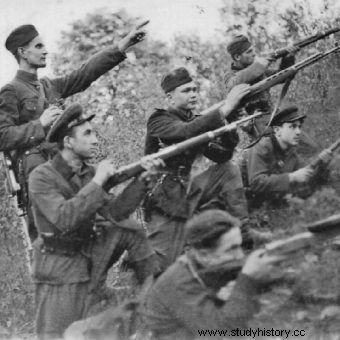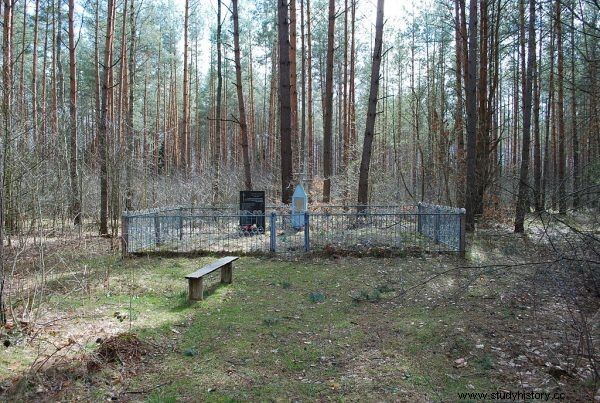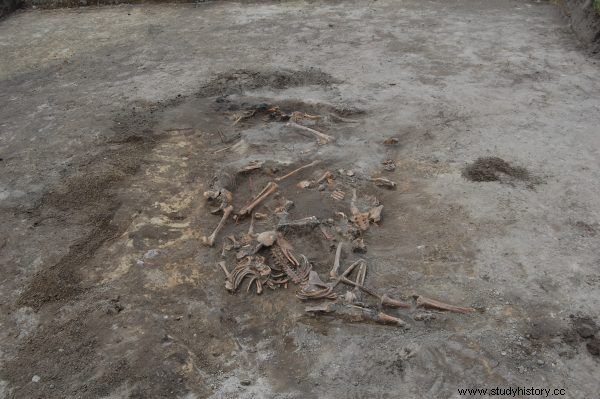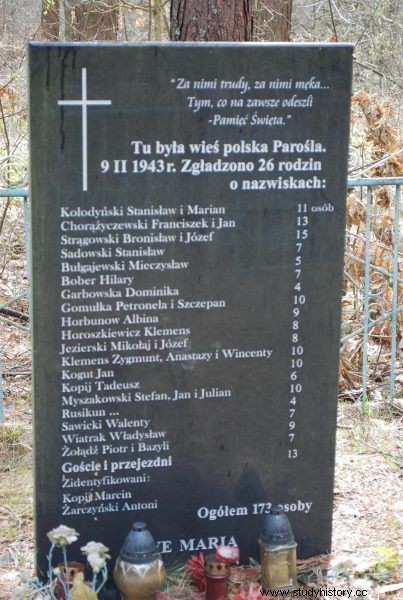When the townspeople saw in the morning an approaching squad of soldiers in Soviet uniforms, they became concerned, but did not panic. They even allowed themselves to be tied up to avoid the punishment that the Germans could impose for "helping the guerrillas." They didn't know they were going to die in agony.
It was Tuesday, February 9, 1943. The Kołodyński family, living in one of the twenty-six homesteads that make up the colony of Parośla, was awakened by insistent pounding on the door. The newcomers - a group of a dozen or so armed men - introduced themselves as members of the Soviet partisans, although they could be recognized as Ukrainians by their appearance and language. In fact, it was a sotnia of the Ukrainian Insurgent Army, commanded by Hryhorij Perehijniak "Dowbeszka-Korobka".

For UPA soldiers (in the photo of the UPA in 1947) the crime in Parosla was a dress rehearsal for the massacre they intended to organize on the Poles in Volhynia.
As Witold Kołodyński, who was 12 years old at the time, recalls, such incursions had already happened before:
From the summer of 1942, Ukrainian patrols, five or six horsemen on horseback, visited the Parośla colony very often. In the autumn-winter period, the same patrols (dressed in suits, postols, armed) were recognized by Poles, e.g. by my father that they were Ukrainians, and not the [Soviet] guerrillas, with which the Poles were in touch.
In December 1942, these patrols took place very often in the early evening hours . Our children were questioned about various matters. Various meetings and deliberations took place in our home, as well as at the Bulgajewski's.
"You have to lie down, we'll tie you up"
Initially, nothing indicated that this time the "visit" would end in a tragedy. The men, leading a few prisoners (Cossacks captured the previous day at the police station in Włodzimierz), settled in a large room and a bedroom. Witek, who was watching the whole situation from the bread oven in the kitchen, did not know it yet, but a similar wake-up call awaited all his neighbors that day.

Mass grave of the inhabitants of Parosla murdered by the UPA.
“The branch is located all over the village. Four, five or six armed people entered each of the huts, ”says Piotr Zychowicz in the book“ Wołyń betrayed ”. "They told the women to bake bread and prepare food." No one was allowed to go outside.
When Witek's mother started cooking and baking, the soldiers searched the house and the farmyard. Ukrainians hoped to find weapons; indeed, she was hidden in the barn. Meanwhile, the boy and his father were severely beaten. They also dealt with the imprisoned Cossacks with the ax.
At around 3 p.m., the assailants seemed to gather to leave, satisfied after the hearty lunch. Finally - under the pretext of caring for the safety of the farm's tenants - the commander of the unit announced that it would be best if his people ... bind the whole family . "You have to lie down, we will tie you up so that the Germans will not hurt you for detaining and feeding partisans," he said.
How is it possible that the Kołodyńskis - and also all other inhabitants of Paros, obeyed this order? According to Ewa and Władysław Siemaszko, researchers of war crimes committed by Ukrainian nationalists:
The reasoning was convincing. At that time, when the Soviet partisans operating in the nearby forests were setting mines, they tied guards to the trees, who were inhabitants of the villages appointed by the Germans to guard the forests near the railway tracks. Faced with such overwhelmed sentries, the Germans did not take any consequences for the Soviet sabotage. Therefore, the inhabitants of Parośla accepted it as natural for "guests" to bind them .
"We heard mom scream ..."
This time, however, instead of leaving the colony tied up and departing, the Ukrainians began murdering. "There were many perpetrators, because we were murdered almost simultaneously," Witek later recounted. Before he passed out, he heard his mother scream, who most likely saw her husband and parents die.
When the boy woke up, the Bandera followers were still pacing the kitchen. There was also a low rattle, cut short quickly by one of the attackers. He dared to get up only when the sound of the creaking sledges away, convinced him that the house was empty.
At about the same time, his younger sister came to her senses. They were both injured - Lila complained that her hair was stuck and that her head hurt. "We were cold, numb, covered in blood" - Kołodyński later described. But a quick glance at the room convinced them that they were lucky anyway:
The sight we saw was terrible. Not to be embraced by a human mind, let alone a child's mind. The parents had their heads split in two. We have a long braid that was cut off. An ax was left in my father's head, which would mean that the groans I heard were being made by my father who had been killed.

The crime in Parosla was the first mass murder of Poles committed by Ukrainians in Volhynia. After this massacre, other massacres soon began (in the photo:a mass grave of the victims of the Volhynia massacre in Wola Ostrowiecka).
In the cradle, the youngest Boguś, 1.5 years old, was hit in the forehead with an ax. For a long time she was in convulsions that were throwing the cradle . Lila took her in her arms and after a while Bogusia ended her life. A "bubble" came out of the nose - it was the brain.
In the remaining rooms, Witek and Lila found more corpses, belonging not only to members of their family, but also to the Cossacks who had been smashed earlier. Wrapped in blankets and rugs that the murderers had not stolen, the children waited out the night. In the morning, they made another gruesome discovery. As Witek reported:
We were convinced that this was the only case with us, because my father was responsible for the gun, he kept it. At my uncle's house, they were all murdered in the same way. Opposite the neighbors, the same view. You can't see a soul. You can hear the terrible howling of dogs . The chimneys were not smoking anywhere.
Murdered Colony
Maybe it was a good thing that the young Kołodyńskis hid back at home. If they went around the village, they would only see more monstrosities. "The militants killed the lying people by hacking their heads and bodies with axes" - describe Władysław and Ewa Siemaszko. “The children were killed by blows to the heads of the axes' heads. In one of the houses it was impossible to get the knife out nailed baby to the table ". In turn, Piotr Zychowicz in the book reports:
Representatives of the local elite were murdered with extreme cruelty. Walenty Sawicki, the commander of the Riflemen's Association, was "chopped into chaff". In turn, Mieczysław Bułgajewski, who tried to resist the murderers, was "cut to pieces". Among the victims were many children, including four-year-old Włodzio, one-year-old Krysia, two-year-old Romek ...

A commemorative plaque with the names of the victims of the crime in Parosla.
The attackers also seized everything that was of any value. The Kołodyński siblings would not survive long under these conditions. Fortunately, on the same day - February 10 - people appeared on the farm and took cold and frightened children to the doctor. Both the boy and the girl had their skulls broken and dented by the axes. These injuries continued for many years after those tragic events.
Witek and Lila were among only twelve survivors who managed to survive the UPA attack. The rest of the colony residents and their random visitors, a total of at least one hundred and fifty-five people, lost their lives. The parośla ceased to exist. And these were not all the victims that day - after the Ukrainians left the village, they killed another fifteen people.
Bandera "training ground"
The crime in Parosla was the first mass slaughter of Polish civilians in Volhynia. For many - especially representatives of the Polish underground - it was a complete surprise. Even at the turn of 1942 and 1943, it was reported to London that "The mood of the masses is of such a nature that any attempts by extreme nationalist organizations, such as the OUN, to lift them into some hopeless mob - will not take on, as can be expected, greater dimensions ”.
The Home Army overlooked the progressive radicalization of Ukrainian nationalists. Meanwhile, while preparing to take over Volhynia, they intended to solve the "Polish question" once and for all. Initially, they flirted with the idea of forcing Poles - with requests and threats - to leave the region. Soon, however, they began to prepare for a larger-scale action.
As historian Grzegorz Motyka notes, the number of protests against Polish families increased significantly already at the beginning of 1943. "With a high degree of probability, we can consider them a sign of preparations for an anti-Polish action," he argues. Parośla was a dress rehearsal, "a training ground for anti-Polish action". "The murder in this town convinced the leadership of the OUN-B that its departments are capable of destroying larger groups of the population" - explains the researcher.
Was it possible at this stage to stop the slaughter, which deprived the lives of tens of thousands of inhabitants of Volhynia in the following months? Piotr Zychowicz thinks so:
There was still a lot of time to take the necessary steps to prevent a large-scale carnage. They would nip the Bandera threat in the bud. After all, the Polish Underground State had an overwhelming advantage over the Banderites.
If the Home Army were seriously involved in Volhynia, the still forming UPA could have been beaten . However, it was necessary to go to the rescue immediately. What did the Home Army Headquarters do at that time - between February and July 1943? Well, she did nothing. Those five months were wasted.
In the absence of a decisive response from the Polish underground, the first one came after the first one. Kolonia Lipniki, Halinówka, Janowa Dolina, Hurby - these and countless other places became spectators of the atrocities of the Bandera followers. But there was one difference:the murder in Parośl became a warning for Poles. And already in February, self-defense troops began to organize themselves, often successfully resisting attackers.
